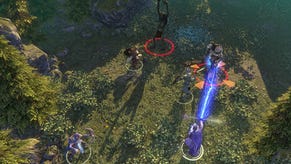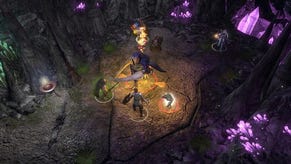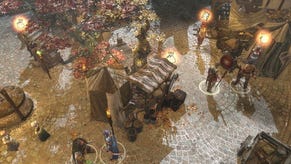Wot I Think: Sword Coast Legends
Blunt
The dream: remote D&D for far-flung or time-starved friends. A cackling dungeon master pulling strings, up to four heroes ganging up on monsters and squabbling over loot, amazing adventures which exist only for you.
The reality of Sword Coast Legends [official site]: not that, basically.
The digital D&D dream might just be an impossible one, as the pen 'n' paper RPG is built upon imagination and conversation. The second that graphics are thrown into the mix, everything changes. The world becomes known, inflexible, constrained by the comparatively few possibilities of screenspace and of clicking a button rather than conjuring places and people from words alone. Even so, Sword Coast Legends pays mere lip service to D&D, taking up the Forgotten Realms setting and the foundational concepts of fights and rewards, but discarding the vital sense of chance and choice.
At its best, it's a functional co-op dungeon-runner in a vaguely Diabloesque vein for one to four players. At its worst it's a dreary trudge through meatless fights in samey environments bordered by a sluggish UI. Part of me thinks I just need to keep fishing for some kernel of do-it-yourself goodness, but a larger part of me thinks that life's just too short.
In theory, the key to Sword Coast Legends is its dungeon master mode, in which one player can do as much as design an area filled with quests and dungeons from scratch, or as little as teleport additional monsters in on the fly while the others stomp through pre-made challenges. Where Neverwinter Nights, SCL's great inspiration, came with a fully-fledged and exceedingly complicated modding toolset, this game has a relatively easy, in-game UI into which you can pretty much just plop whatever you like. I was able to knock together a rudimentary dungeon with a couple of functional quests and a boss in around 20 minutes; given a couple of hours I could have gone to town on purple prose and consciously hardcore challenges. It's hard to argue with DM mode's ease.
The trade-off for this is flexibility: I don't doubt that more ingenious modders will find ways to achieve more interesting things, but right now it seems unlikely that we'll get more than go here > kill or collect that with as much flavour text as the DM can be bothered with. It's early days of course, but so far every user-made module I've tried has seemed pretty damned similar to the last one, primarily depending on how fiendish the creator is in terms of monster and trap placement.
It doesn't help that, graphically, SCL falls into whatever the exact opposite of a sweet spot is. It's neither lo-fi enough for imagination to augment simple sights, or fancy-pants enough to make the simple act of wandering around pleasurable or surprising. It's not actually locked into the notorious greys and browns of 3D games from not so long ago, but it somehow feels like it is. Yeah, the archetypal high fantasy of the Forgotten Realms setting isn't the most fertile soil for wildness, but neither is it an impediment to it.
Add to that the more nebulous but inescapable issue of combat feeling mechanical and perfunctory, and SCL's biggest problem isn't really that it doesn't feel sufficiently like an AD&D session - it's that it's simply an unexciting place in which to kill monsters in unexciting ways. The clicky, weightless combat and the 2000s MMO hotbar UI are just the dull grey icing on the bland, dry cake.
At this point I'm going to open the floor to m'learned colleagues John and Graham, who were on the receiving end of my only slightly confused dungeon-mastering. They've only played a fraction of what I have, but I think it's valuable to hear the perspective of folk who've purely had an adventure made for them - the apparent true purpose of Sword Coast Legends.
John:
"I was genuinely surprised by its strange, shoddy appearance. During the promotion for the game I had gotten the impression this was going to be a means to run your own D&D campaigns with chums, online. Something that's enormously needed. But instead this appears to be a sub-Diablo brawler with incredibly clumsy combat, dreary presentation, and not a dice roll in sight.
Clearly this was only a brief glance, but it wasn't one that has given me any inclination to dig any deeper. It seems we still desperately need someone to come up with the ultimate AD&D online DMing extravaganza, cos this ain't it."
And Graham:
I like user-created content and I like collaboratively authored experiences of the kind Sword Coast Legend proposes, and I am willing to put in hours in order to learn strange systems and awkward toolkits to make those situations happen. If - if - there is a core experience there that seems worthwhile, that is. Sword Coast Legend feels to me like dull hotbar combat from fifteen years ago. When you're making a D&D game which focuses on the combat side of the experience, making those fire balls and magic missiles feel great is essential, and without that I feel little motivation to put up with everything else. Not the lagging quest givers or the slow load times or the plain, grey environments or the enemies who steamrolled over my new character in single hits.
That last is worth picking up on. While SCL's DM tools are designed to be easy, and introducing or removing monsters is straightforward, by default there's no fine control with which to truly tailor a module to your mates' characters and capabilities. It's broad-strokes easy/medium/hard, with options to slightly buff or debuff enemies once the session's begun. (More interestingly, the DM can set any creature as friendly in order to help out with harder encounters and there's even the option to possess a creature and take direct control, Dungeon Keeper style - be it to help or hinder the adventurers. However, if you want to go wade into the Custom Creature Set option, you can assemble a more bespoke set of menaces, with hand-picked powers and levels, as well as appearance. Fear my Purple Mastiff Of Ultimate Purplosity:
It can release a smelly cloud, summon skellingtons and make people feeble, y'know. Even then, there are huge limitations on how many points you can add, plus you can't create a Creature Set that mixes from different types of enemy: an undead set is an undead set, though at least you can change colours and powers. You can even change allegiance, making it possible to build a friendly army to assist your adventurers against a tougher enemy gang if you so wished.
The possibilities seem to run out rather quickly, however. You can't custom-build locations as such, but instead pick from prefab sizes and decorations, and a combination of scripting and random generation handles the rest. Easy, yes, but it means nothing feels special - each new dungeon is just one more from the dungeon machine. You can festoon it with text notes and incidental scenery - from furniture to corpses - but I've yet to find anything, either official, self-made or from the slowly-populating ranks of player-made modules, which feels especially distinctive.
That said, this is a game that will live and die on the long-term narrative enthusiasm of module-makers, both in written text and in the on-the-fly narration from the DM. I suspect the best is yet to come there, presuming people stick around. In our case, the session involved an inexperienced DM trying to corral two fellow critics who were too dismayed by the lacklustre presentation, humdrum combat and laggy dialogue boxes to give themselves over to RP. Approach it as nothing more than a place to hang out and bash monsters with friends, one of whom is embellishing every sight and every fight with sibilant delight, and it might just about do the job. There are some playful modules to be found in the in-game download menus, and while they couldn't escape the essential sameiness, there is something to be said for setpiece fights (like the one pictured above) and enthusiastic flavour text everywhere.
Some fairly rapid patching is needed, however. For instance, all three RPSers who played suffered from the game trying to play in a window, which necessitated a manual alt-enter intervention as the Fullscreen button in settings does nothing, but even that wouldn't work all the time. The Invite button in multiplayer was similarly non-functional: we got around by joining each other's games via the Steam interface.
Meanwhile, alt-tab does bad things, it's taxing my system more than a game which looks like this could possibly justify, and spiking lag laid multiplayer sessions low, with NPCs not offering up their dialogue boxes until several seconds after repeated clicking. Even playing solo, I had dialogue boxes act up all over the place. SCL certainly isn't in a disastrous state, but it does feel rickety right now. On the plus side, drop in/drop out multiplayer worked well, and no-one needed to do any further fiddling to jump into a game. Same's true of playing with randoms. Clearly it's a very different experience from playing with your mates, but finding and joining sessions was perfectly straightforward.
It's definitely best to think of Sword Coast Legends not as Dungeons & Dragons (let alone AD&D) and more as a sort of low-key DIY Diablo. Even then, the core combat is too forgettable, and the DM mode too limited, to make a solid case for playing this instead of co-op Diablo or Torchlight or Titan Quest or Path of Exile if monster-bothering with chums is what you're after. It's not impossible that later updates will make fighting feel less underwhelming or expand the potential of dungeon-building, but I wouldn't want to bet on it.
It's absolutely true to say that you get out of Sword Coast Legends what you put in, but right now there just aren't enough reasons to put much in.
Sword Coast Legends is out now for Windows, Max and Linux.















